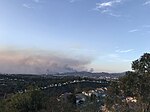Santiago Dam
Dams completed in 1931Dams in CaliforniaUnited States local public utility dams

Santiago Dam (also known as Santiago Creek Dam) is an earth/rockfill dam across Santiago Creek in Orange County, in the U.S. state of California, forming Irvine Lake. The 136-foot (41 m) earth dam and its reservoir serve for flood control and recreational purposes. It lies upstream (southeast) from the city of Orange and north of Irvine. Irvine Lake is the largest body of fresh water entirely in Orange County.
Excerpt from the Wikipedia article Santiago Dam (License: CC BY-SA 3.0, Authors, Images).Santiago Dam
Lake View,
Geographical coordinates (GPS) Address Nearby Places Show on map
Geographical coordinates (GPS)
| Latitude | Longitude |
|---|---|
| N 33.786111111111 ° | E -117.72527777778 ° |
Address
Lake View
Lake View
California, United States
Open on Google Maps







